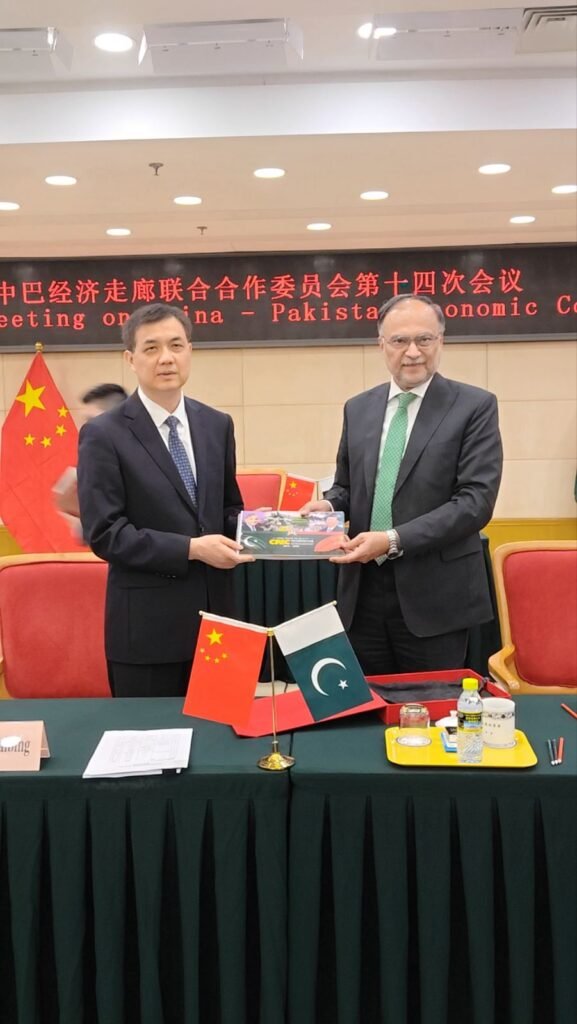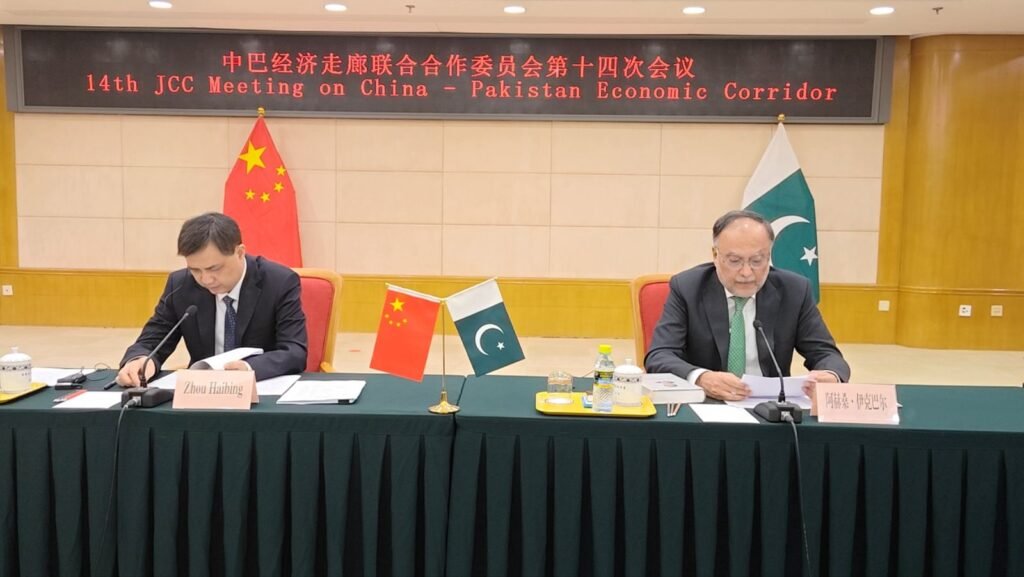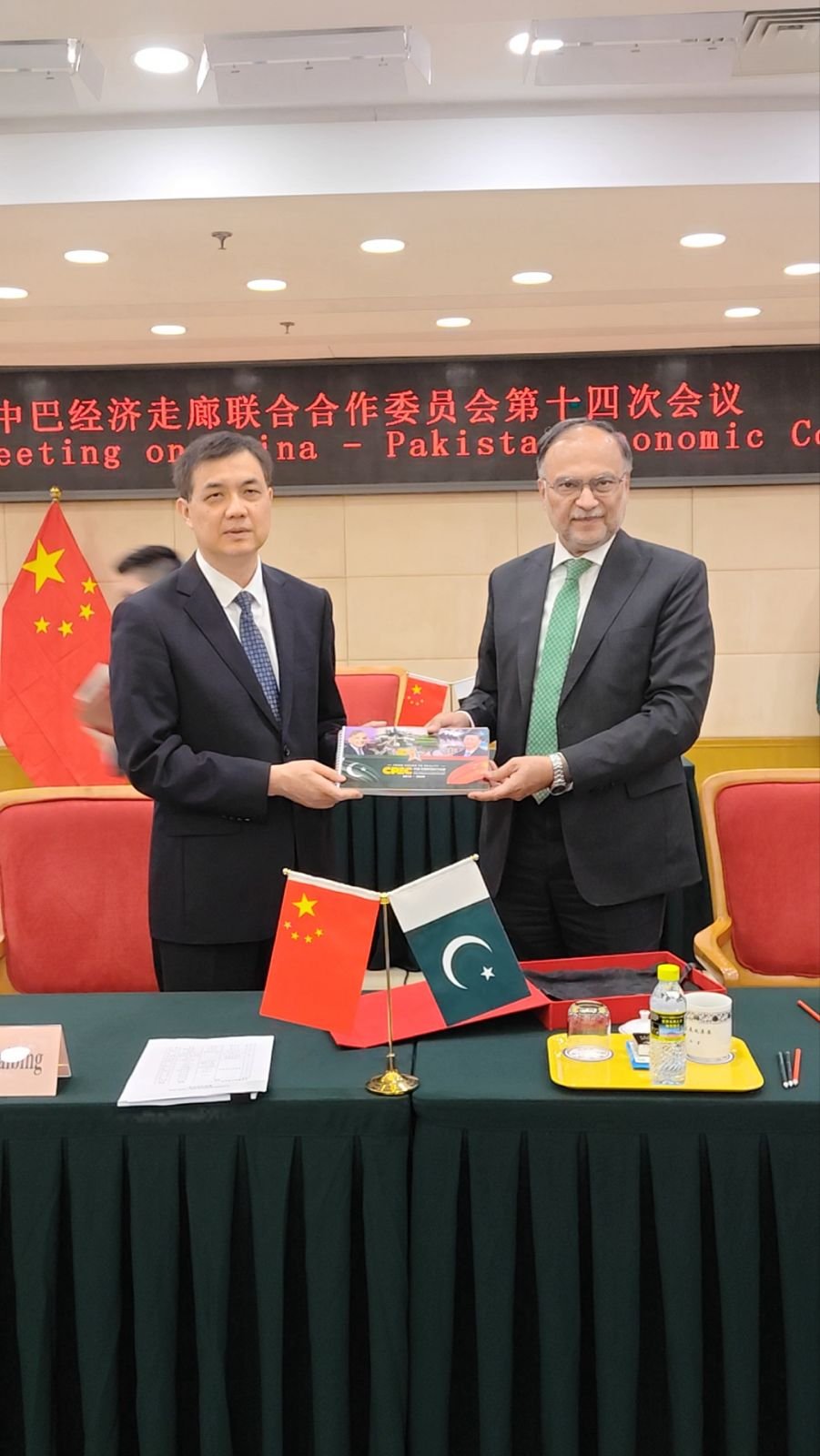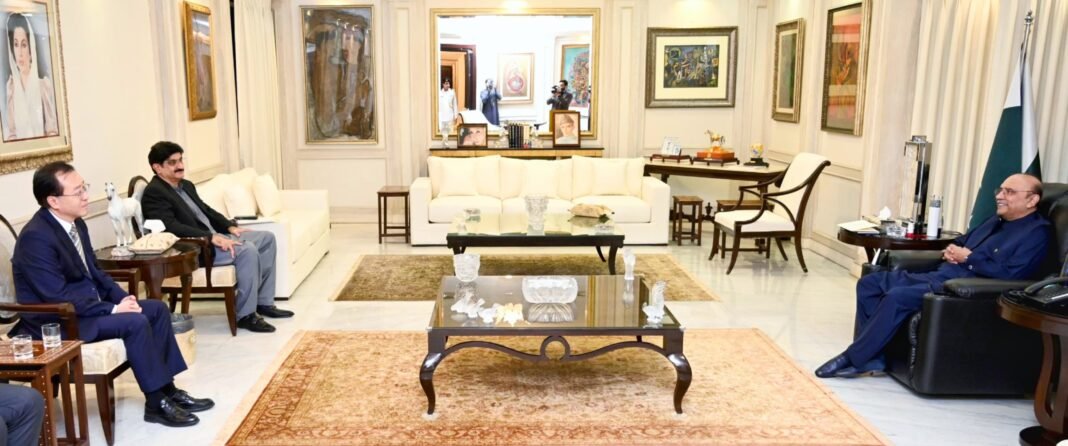
Beijing : Federal Minister for Planning, Development and Special Initiatives, Professor Ahsan Iqbal, inaugurated the 14th meeting of the Joint Cooperation Committee (JCC) of the China–Pakistan Economic Corridor (CPEC) with a landmark address that set the tone for a new era of high-quality, inclusive, and people-centered development under CPEC Phase II.
IMinister reaffirmed that Pakistan and China are not merely partners but “iron brothers,” bound together by trust, sacrifice, and a shared destiny. He emphasized that this unique relationship is immune to geopolitical fluctuations or changes in governments and is firmly anchored in the hearts of the people of both countries. Paying tribute to President Xi Jinping, Ahsan Iqbal extended Pakistan’s deep appreciation for his historic global initiatives — the Belt and Road Initiative (BRI), the Global Development Initiative (GDI), the Global Security Initiative (GSI), and the Global Civilization Initiative (GCI). He noted that for Pakistan, these are not abstract policy concepts but living realities, most tangibly embodied in the success of CPEC.
Reflecting on his own role in the journey of CPEC, Professor Iqbal recalled that before 2015, CPEC was only a concept on paper. Under the visionary leadership of Prime Minister Muhammad Nawaz Sharif, it was transformed into a portfolio of over $46 billion, spread across critical sectors of Pakistan’s economy. He added that of the 14 JCC meetings convened since its inception, he has had the distinct honor of co-chairing 11, witnessing first-hand the evolution of CPEC from an idea to a transformative reality. He expressed gratitude to the National Development and Reform Commission (NDRC) of China for its unwavering support and continuity of commitment to the project.

The Minister provided a detailed account of the historic achievements of CPEC Phase I. He underlined that Pakistan’s energy security was restored through 17 major projects worth nearly $18 billion, which added more than 8,000 megawatts to the national grid. These projects ended crippling power shortages, tapped the vast coal reserves of Thar, and diversified the energy mix into hydropower and renewables, changing the lives of millions of citizens. Connectivity was enhanced through the completion of 888 kilometers of modern highways that bind regions of Pakistan into a single economic space, while the modernization of the 150-year-old ML-1 railway network is poised to revitalize the backbone of the national transport system. Gwadar, once a quiet fishing town, has begun to emerge as Pakistan’s maritime gateway. With Chinese grant assistance, a hospital, vocational training center, airport, desalination plant, and solar facilities have been established, laying the foundation for Gwadar to serve as a regional logistics hub linking Pakistan with Central Asia and the Gulf.
Looking ahead, Ahsan Iqbal made clear that Phase II of CPEC must raise the edifice of high-quality, inclusive, and sustainable growth on the strong foundations already built. He declared that the next stage must be defined by “youth at the core, people in the lead, and exports as the engine of growth.” He proposed that nearly 60 percent of Pakistan’s young population be positioned at the center of this transformation, with 10,000 PhD scholarships in artificial intelligence, engineering, and emerging sciences offered at top Chinese universities over the next decade. He further proposed vocational training programs, youth innovation centers, and internships in Chinese enterprises to prepare Pakistan’s youth for leadership in advanced technologies, green industries, and innovation-driven sectors.
The Minister stressed that people must remain at the heart of CPEC Phase II. He suggested piloting China’s highly successful poverty alleviation model in one of the poorest districts of each province and region of Pakistan. He highlighted the need to replicate China’s rural–urban linkages through e-commerce, agro-logistics, and digital platforms, which would allow farmers, workers, women, and small entrepreneurs in Pakistan to directly access larger markets in both countries. This, he said, would make the Livelihood Corridor of CPEC a vehicle of direct socio-economic uplift.
Professor Iqbal underscored that exports must serve as the main driver of economic growth in the next phase. Noting that China’s annual imports exceed $2 trillion, while Pakistan’s exports to China are just $3 billion, he urged that Pakistani products be given the same market access as ASEAN countries. He called for the development of two government-to-government special economic zones (SEZs) in Karachi and Islamabad as model export-oriented hubs, where industrial relocation from China in textiles, engineering, electronics, pharmaceuticals, and electric vehicles could be prioritized. He also proposed the establishment of a Pakistan–China Industrial Relocation Fund to de-risk investors and accelerate foreign direct investment.
Expanding on the five new corridors of CPEC Phase II — the Growth Corridor, Innovation Corridor, Green Corridor, Livelihood Corridor, and Regional Connectivity Corridor — the Minister outlined a detailed roadmap. He called for the launch of a Pakistan–China Digital Silk Road program with investments in 5G, fiber-optics, and data centers, and the creation of joint laboratories in artificial intelligence and quantum computing. He also highlighted the need for joint research in robotics, fintech, and biotechnology under a CPEC Future Skills Program. In the Green Corridor, he proposed a Joint Working Group on Water and Climate Resilience to help Pakistan develop its national climate strategy, expansion of renewable energy manufacturing to ensure 60 percent clean energy by 2030, and the piloting of electric mobility and climate-smart agriculture projects. For the Livelihood Corridor, he stressed modernizing agriculture with hybrid seeds, drip irrigation, livestock development, and agro-processing zones supported by cold chain logistics.
Discussing regional connectivity, he urged fast-tracking the Thakot–Raikot realignment of the Karakoram Highway and the modernization of ML-1. He proposed a Mining Corridor from Chaghi to Gwadar to harness Pakistan’s mineral wealth, as well as integrated border markets at Khunjerab, Torkham, and Gwadar. He further suggested the development of a cross-border fiber-optic backbone to position Pakistan as a digital hub, and the establishment of a Pakistan–China–Afghanistan–Central Asia Connectivity Group to integrate road, rail, and digital connectivity across the region.
Acknowledging the special importance of Gilgit-Baltistan as the physical gateway of CPEC, Professor Iqbal proposed a 300 MW solar project to end the region’s 18–20 hour daily blackouts and to transform its economy. He also emphasized that the future of CPEC must pivot from government-to-government cooperation to business-to-business partnerships. Citing the recent Pakistan–China Investment Conference, where 800 firms signed memoranda of understanding worth $8.5 billion, he declared that private enterprise must become the new driver of CPEC 2.0. To provide clear strategic direction, he proposed the publication of an updated CPEC Long-Term Plan within 45 days, aligning Pakistan’s URAAN 5Es framework with President Xi’s five corridors of CPEC 2.0.
Concluding his remarks, the Minister unequivocally reaffirmed Pakistan’s highest priority to ensure the safety and security of Chinese personnel and projects, recognizing peace and stability as the foundation of the partnership. He urged that CPEC Phase II should not merely be remembered for its power plants and highways but as a corridor of hope, innovation, opportunity, and shared prosperity, with youth as innovators.
Sohail Majeed is a Special Correspondent at The Diplomatic Insight. He has twelve plus years of experience in journalism & reporting. He covers International Affairs, Diplomacy, UN, Sports, Climate Change, Economy, Technology, and Health.






![logo-1[1]](https://globalnewspakistan.com/wp-content/uploads/2025/01/logo-11-e1737618310315-300x187.png)